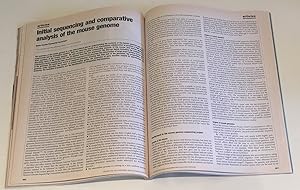Waterson R H Lindblad Toh Birney Rogers (1 results)
Product Type
- All Product Types
- Books (1)
- Magazines & Periodicals
- Comics
- Sheet Music
- Art, Prints & Posters
- Photographs
- Maps
-
Manuscripts &
Paper Collectibles
Condition
- All Conditions
- New
- Used
Binding
- All Bindings
- Hardcover
- Softcover
Collectible Attributes
- First Edition
- Signed
- Dust Jacket
- Seller-Supplied Images
- Not Printed On Demand
Seller Location
Seller Rating
-
Initial sequencing and comparative analysis of the mouse genome. (With several related articles), pp. 520-562 in: Nature, vol. 420, no. 6915, 5 December 2002. SEQUENCING THE MOUSE GENOME
Published by London: Nature Publishing Group, 2002
Seller: Landmarks of Science Books, Richmond, United Kingdom
Book First Edition
Soft cover. Condition: Near Fine. 1st Edition. First edition, complete journal issue in original printed wrappers, of the first announcement of the sequencing of the mouse genome - the genetic blueprint of a mouse - together with a comparative analysis of the mouse and human genomes describing insights gleaned from the two sequences. "The achievement represents a landmark advance for the Human Genome Project. It is the first time that scientists have compared and contrasted the contents of the human genome with that of another mammal. This milestone is all the more significant given that the laboratory mouse is the most important animal model and is widely used in the study of human diseases . . . The mouse sequence provides scientists a powerful research tool to extract meaning from the human genome sequence, the "Book of Life" published in draft form last year. It allows them to recognize functionally important regions in the human genome by virtue of the fact that they are conserved through the 75 million years of evolution separating humans and mice. 'This is an extraordinary milestone. For the first time we have an opportunity to see ourselves in an evolutionary mirror,' says Eric Lander, Ph.D., director of the Whitehead/MIT Center for Genome Research. 'The mouse genome represents a very important chapter in evolution's lab notebook. Being able to read this notebook and compare genomic information across species allows us to glean important information about ourselves.' Because the mouse carries virtually the same set of genes as the human but can be used in laboratory research, this information will allow scientists to experimentally test and learn more about the function of human genes, leading to better understanding of human disease and improved treatments and cures . . . The sequence shows the order of the DNA chemical bases A, T, C, and G along the 20 chromosomes of a female mouse of the 'Black 6' strain - the most commonly used mouse in biomedical research. It includes more than 96 percent of the mouse genome with long, continuous stretches of DNA sequence and represents a seven-fold coverage of the genome. This means that the location of every base, or DNA letter, in the mouse genome was determined an average of seven times, a frequency that ensures a high degree of accuracy . . . Comparison of human and mouse genomes - some highlights: The mouse genome is composed of 2.5 billion bases. This is about 14 percent shorter than the human genome. The human genome has more repeated DNA sequences than does the mouse genome; Although mice and humans are separated by 75 million years of evolution, 90 percent of the mouse genome can be aligned with large segments of chromosomes in the human genome; The number of genes estimated to be in the mouse genome was about 30,000. This is similar to the number estimated to be in the human genome. As with humans, this number was later lowered to the 20,000-25,000 range" (National Human Genome Research Institute). Large 8vo, pp. xxxviii, 447-590, [6], 56, with large foldout genome map loosely inserted. Original printed wrappers (very minor wear to extremities).


